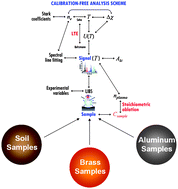The calibration-free methodology described in the literature dealing with the technique of laser induced breakdown spectroscopy has been applied here to several samples under different operating pressures with the aim of classifying the analytical technique as quantitative, semi-quantitative or qualitative (with quantitative estimates only), depending on the relative percentage errors calculated for the major, minor and trace elemental composition of the sample. The results were obtained with a Q-switched Nd:YAG laser (1064 nm), characterized by 5.3 ns duration pulses at a maximum repetition frequency of 10 Hz and with pulse energy up to 300 mJ. The spectra were taken with a grating monochromator coupled with an intensified CCD detector, calibrated from 220 to 700 nm. The samples investigated were aluminum alloy standard disks, standard reference materials of Zn alloy, Cu–Ni alloy, Ti alloy, Ni alloy powder, Cu–Zn alloy and soils. The data are compared with those published in the literature. The results show that the best accuracy (5% relative error) is usually obtained for the matrix element, while in most cases, for the remainder of the components in the sample (major, minor or trace composition), the results can only be considered semi-quantitative (<200% relative error).

You have access to this article
 Please wait while we load your content...
Something went wrong. Try again?
Please wait while we load your content...
Something went wrong. Try again?


 Please wait while we load your content...
Please wait while we load your content...